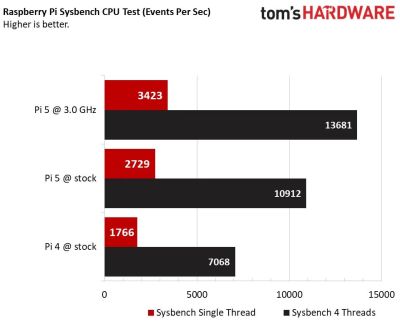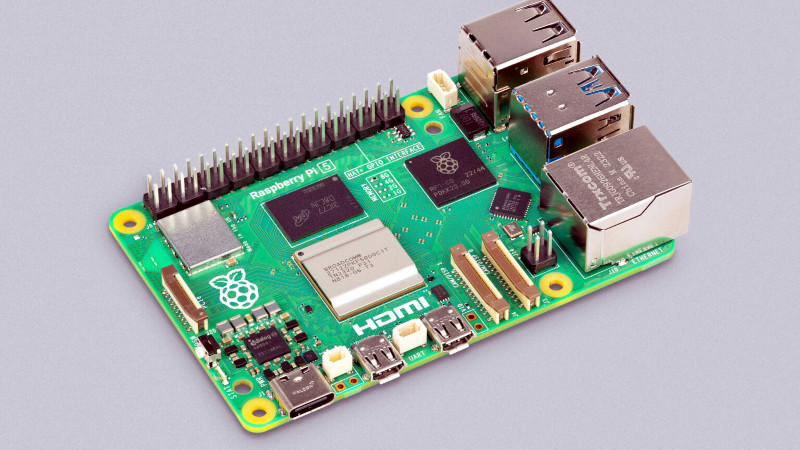Overclocking computer systems is a fun way to extract some free performance, or at least see how far you can push the hardware before you run into practical limitations. The newly released Raspberry Pi 5 with BCM2712 SoC is no exception here, with Tom’s Hardware having a go at seeing how far both the CPU and GPU in the SoC can be pushed. The BCM2712’s quad Cortex-A76 CPU is normally clocked at 2.4 GHz and the VideoCore VII GPU at 800 MHz. By modifying some settings in the /boot/config.txt configuration file these values can be adjusted.
 In order to verify that an overclock was stable, the Stressberry application was used, which fully loads the CPU cores. Here something like a combination of stress-ng and glxgears could also be used, to stress both the CPU and GPU. With the official actively cooled heatsink the CPU reached a temperature of 74°C with a whole board power usage of about 10 Watts. At idle this dropped to 3 Watts at 46°C. At these speeds, the multiple Raspberry Pi 5 units OCed by Tom’s Hardware were mostly stable, though one of the team’s boards experienced a few crashes. This suggests that this level of OCing could still be subject to luck of the draw, and long-term stability would have to be investigated as well.
In order to verify that an overclock was stable, the Stressberry application was used, which fully loads the CPU cores. Here something like a combination of stress-ng and glxgears could also be used, to stress both the CPU and GPU. With the official actively cooled heatsink the CPU reached a temperature of 74°C with a whole board power usage of about 10 Watts. At idle this dropped to 3 Watts at 46°C. At these speeds, the multiple Raspberry Pi 5 units OCed by Tom’s Hardware were mostly stable, though one of the team’s boards experienced a few crashes. This suggests that this level of OCing could still be subject to luck of the draw, and long-term stability would have to be investigated as well.
As for the practical use cases of OCing your Raspberry Pi 5, benchmarks showed a marked uplift in compression and Sysbench benchmark scores, but OCing the GPU had no real positive impact on YouTube or 3D performance, leading even to a massive increase in dropped frames with video playback. This probably means that increasing the CPU clock may be beneficial, but OCing the GPU could be futile without also OCing the RAM frequency, if at all possible.
Realistically, the Raspberry Pi SoCs never were speed monsters, with even the Raspberry Pi 4B’s SoC being beaten handily in 2020 by a budget dual-core Intel CPU. The current Intel Alder-Lake-N-based N100 SoC has a 6 Watt TDP and boosts up to 3.4 GHz while its Xe-LP-based iGPU (with AV1 decoding support) makes for a decent gaming experience within a ~16 Watt power envelope. Clearly, any OCing of the Raspberry Pi boards is more for the challenge of it, but then so is running the latest Intel CPU at 10 GHz with liquid nitrogen cooling.

















” but then so is running the latest Intel CPU at 10 GHz with liquid nitrogen cooling.” … Why not stick nitro cooling on the pi5?
1. The chip package for the Pi5 CPU would likely fracture in nitro. 2. RAM speed would limit performance so higher clock wouldn’t add more performance.
What about dry ice, say, in special plastic bags?
It’s not liquid nitrogen, but still has a nice -78,5° C.❄️
Other than heat sinks and fans the only sustainable cooling solution would be some kind of liquid cooling rig with a radiator. But the rest of the Pi would not keep up with a much faster CPU.
I agree that there’s not much performance to be gained from liquid nitrogen cooling a pi besides the “so we can say we did” factor, but LN2 cooling doesn’t generally involve (or require) dumping liquid nitrogen directly on the CPU. People have successfully cooled the PI 4 down below -80 celsius and it runs just fine (see https://www.youtube.com/watch?v=RbzKM5XxlOA for example). I don’t see why the Pi 5 would be different.
Properly cooling a RPi has always been problematic. If the hot things were on the bottom of the PCB, passive cooling would be easy by using a metal case and a silicone pad. It’s a shame that this design flaw still isn’t fixed in the fifth incarnation of a mass product.
Yeah, why don’t they put the hot chip on the flat side?
Perhaps it would need an extraordinary amount of through hole VIAs which would increase cost.
Nah. Many cheap (and not so cheap) network appliances are built with a “hot bottom” in a metal case. Raspberry probably traded functionality for a more sexy look.
vias are basically free, and “all” they would need to do is flip the board and put the connectors on the opposite side
Is there a sleep mode? Or not this time
Haven’t seen any mention of sleep mode.
However I did see in passing mention of ‘suspend mode’ : “In future it may support a low power suspend mode which will boot much more rapidly, “
I once saw a test from “learning computers” (or something like that, a popular youtuber) of a Risc-V test. It did the “lava filter” in blender in some 450 or so seconds, while the raspi did it in about 30 seconds.
so I was curious and ran the lava filter on my 5600G (which costs around EUR130 these days) and it did it in under 2 seconds, and it barely had time to start up a few threads (it’s a 6-core 12 thread processor).
but overall, you won’t buy a raspi when you need performance. It’s plenty usable for a lot of small tasks. But still, it would be nice to have a website which lists reliable performance numbers for all those small processors. Much like cpubenchmark.net but then for all those ARM processors, and other architectures used in those small SOC’s.
Get ready for the Raspberry Pi 6:
– 4c/8t Intel x86_64 Atom processor at 3.5 GHz
– starting at 8 GB of ram
– onboard eMMC, plus M.2 2230
– 4x USB 3.0
– Google Coral TPU expansion option
– 2.5G ethernet
– $100 starting price
Available only high volumes for certified industrial partners or limited “you can buy only 1 piece when available” ;)
Sadly all of this is far too realistic.
Raspberry should maybe look at even better performing Arm CPUs.
Like the Apple M2… :D :D :D